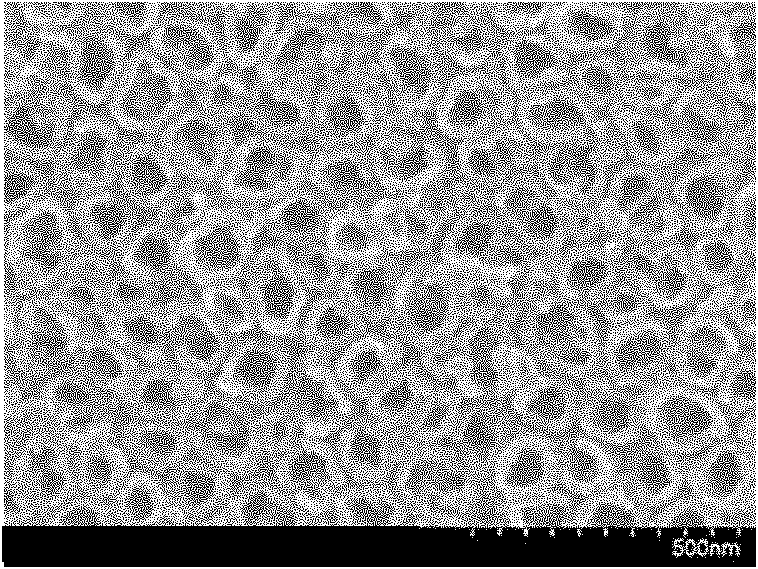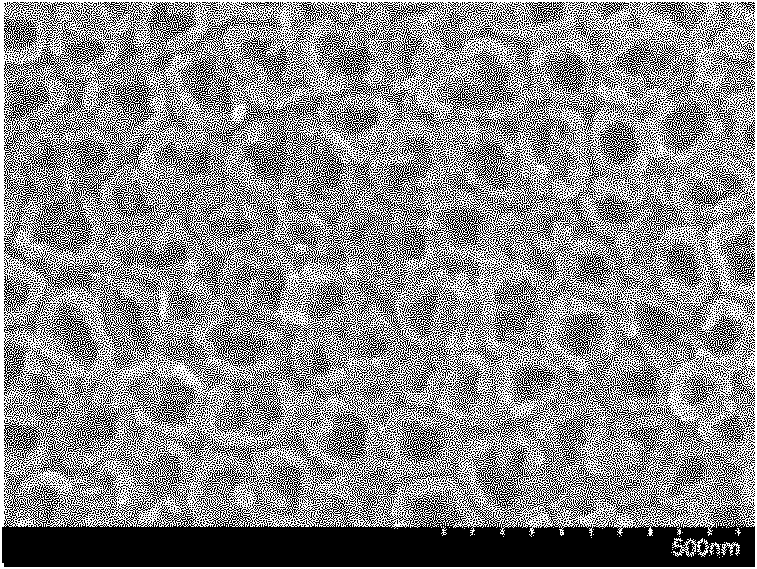Method for preparing iron oxide nano granule modified titanium dioxide nano tube array
A nanotube array, iron oxide nanotechnology, applied in catalyst activation/preparation, chemical instruments and methods, metal/metal oxide/metal hydroxide catalysts, etc., can solve the problems of unfavorable industrialized production, complex preparation process, etc. Achieve the effect of improving utilization, simple operation and improving absorption capacity
- Summary
- Abstract
- Description
- Claims
- Application Information
AI Technical Summary
Problems solved by technology
Method used
Image
Examples
Embodiment 1
[0020] 1) The base material is a pure titanium plate with a thickness of 2mm. The surface is polished with metallographic sandpaper until there are no scratches, cleaned with acetone, ethanol and three times of ultrasonic cleaning in water, and dried in air for use. Prepare an electrolyte solution of 0.5wt% HF, use platinum as the counter electrode at room temperature, and perform electrochemical anodization at 20V for 30min, that is, to obtain ordered TiO on the surface of the titanium plate 2 The nanotube array film layer has an inner diameter of 80-90nm and a film thickness of about 500nm.
[0021] 2) Using a combination of ultrasound and impregnation to prepare Fe 2 o 3 Nanoparticle-modified TiO 2 array of nanotubes. Place the sample prepared in step (1) in 0.1mol / L Fe(NO 3 ) 3 Sonicate the solution for 40 minutes, take it out, rinse it with distilled water, and let it stand to dry. Fe 2 o 3 Nanoparticle-modified TiO2 array of nanotubes. From figure 1 It can be s...
Embodiment 2
[0024] 1) TiO 2 The preparation of the nanotube array film layer is the same as in Example 1.
[0025] 2) Using a combination of ultrasound and impregnation to prepare Fe 2 o 3 Nanoparticle-modified TiO 2 array of nanotubes. Place the sample prepared in step (1) in 0.5mol / L Fe(NO 3 ) 3 Sonicate the solution for 8 minutes, take it out, rinse it with distilled water, and let it dry. The sample was calcined at 450°C for 2 hours, then cooled naturally to obtain Fe 2 o 3 Nanoparticle-modified TiO 2 array of nanotubes. From figure 2 It can be seen that Fe 2 o 3 Nanoparticle Quantity Comparison figure 1 significantly increased, and some nanoparticles had been deposited inside the nanotubes. The results of EDS quantitative analysis showed that the atomic percentage of Fe was 0.77%.
[0026] 3) Fe 2 o 3 Nanoparticle-modified TiO 2 The test of the apparent rate constant k of the visible light catalytic degradation of methylene blue by the nanotube array photocatalyst ...
Embodiment 3
[0028] 1) TiO 2 The preparation of the nanotube array film layer is the same as in Example 1.
[0029] 2) Using a combination of ultrasound and impregnation to prepare Fe 2 o 3 Nanoparticle-modified TiO 2 array of nanotubes. Place the sample obtained in step (1) in 0.5mol / L Fe(NO 3 ) 3 Sonicate the solution for 15 minutes, take it out, rinse it with distilled water, and let it stand to dry. The sample was calcined at 500°C for 2 hours, then cooled naturally to obtain Fe 2 o 3 Nanoparticle-modified TiO 2 array of nanotubes. From image 3 It can be seen that Fe 2 o 3 The amount of nanoparticles compared figure 2 Significantly increased, a large number of nanoparticles have been deposited in the nanotubes. EDS quantitative analysis results showed that the atomic percentage of Fe was 1.18%.
[0030] 3) Fe 2 o 3 Nanoparticle-modified TiO 2 The test of the apparent rate constant k of the visible light catalytic degradation of methylene blue by the nanotube array p...
PUM
| Property | Measurement | Unit |
|---|---|---|
| The inside diameter of | aaaaa | aaaaa |
| Thickness | aaaaa | aaaaa |
Abstract
Description
Claims
Application Information
 Login to View More
Login to View More - R&D
- Intellectual Property
- Life Sciences
- Materials
- Tech Scout
- Unparalleled Data Quality
- Higher Quality Content
- 60% Fewer Hallucinations
Browse by: Latest US Patents, China's latest patents, Technical Efficacy Thesaurus, Application Domain, Technology Topic, Popular Technical Reports.
© 2025 PatSnap. All rights reserved.Legal|Privacy policy|Modern Slavery Act Transparency Statement|Sitemap|About US| Contact US: help@patsnap.com



